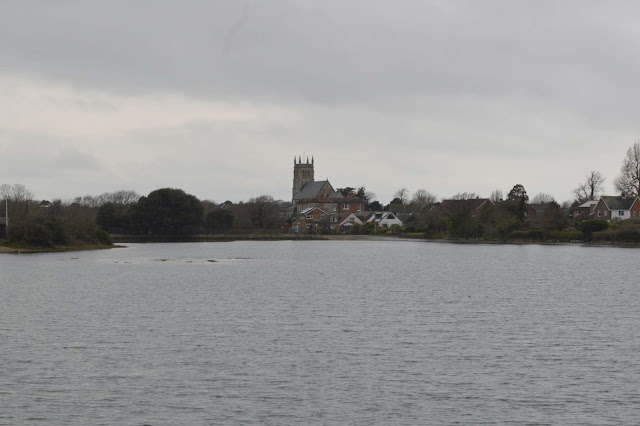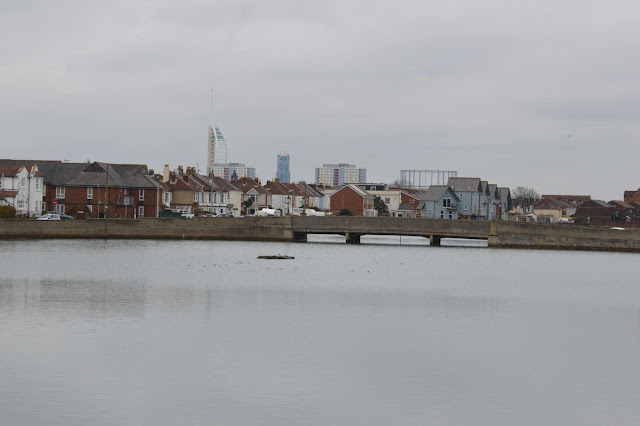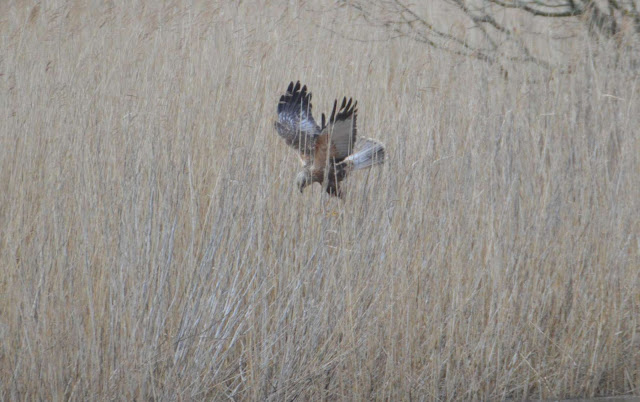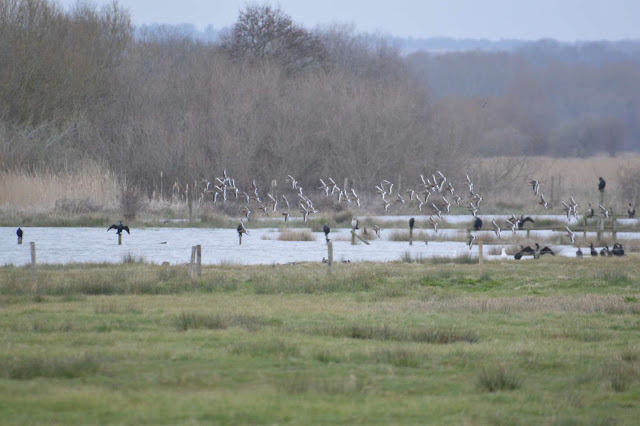It's MOD land with restricted access but on the majority of days it's available to explore.
It's a shingle heathland with gorse as the predominate shrub cover. It's also an SSSI or Site of Special Scientific Interest and has a rich biodiversity. Species that inhabit this special place include Adder, Dartford Warbler, Lesser Whitethroat, Nightjar ; Grayling, Small Copper, Green and Purple Hairstreak Butterfly, Six Spot Burnet Moth, Thrift, Vipers Bugloss, Heather, Foxglove and Bladder Campion to name but a few.
I was planning to walk along the coast path towards Stokes Bay, through Alverstoke and into Gosport. Some 4 miles distant.
As I began my journey, Kes soared above my head and strangely headed out to sea towards the Isle of Wight.
The sounds on Browndown were full of Spring. Greenfinch thrive here and their piercing song filled the air along with their circulatory display flights performed by the males. There are several territories here.
Overhead I could hear the whining calls of Mediterranean Gulls as they flew West.
Crunching across some of the deeper stones can be hard work and noisy too. I try to keep to the compacted paths and grass to lessen the sound.
I spotted a Buzzard gliding along the low tree line and land not far from me. I stalked it trying to avoid being seen by using the gorse as cover.
As I hid behind the shrubbery taking photos, Magpies came in a gave it the usual Corvid cursing.
This eventually drove it off to somewhere a little more quiet. Sometimes it's hard being a raptor.
I had wound my way past Browndown and into Stokes Bay which has a road on it's border by the shore plus a few cafes and restaurants dotted along the edge.
This is a derelict Fort built between 1863 and 1871 in a semi circular arc to protect any invading armies coming through The Solent.
It has lain dormant until recently when works have begun to strip away the banks to the fort and adjacent area by a real estate construction company looking to convert the historic building to luxury accomodation.
This has been a hugely contentious issue with the local population over the disregard for rare local wildlife and rights of way. This is still ongoing as I write this. Suffice to say there was no ecological survey of the area and many species have lost their homes as a result. After the initial clearance phase there is no definitive plan to start building in the foreseeable future. What the future holds is a matter on conjecture.
I have visited here many times viewing, photographing and enjoying the nature here. A lot of that has been lost but parts on the periphery remain, so there is some hope, depending on the impact of the building works - when, and indeed if, it begins.
Adjacent to this is a golf course that cuts through the whole area with two large lakes fed by the sea.
As luck would have it a female Goosander - quite rarely seen here - was swimming and feeding close by.
The Solent Way footpath now directs you inland for a short while as you negotiate Fort Monckton which is a heavily fortified MOD building where matters unknown to us happen in the name of national security. Next to this is the Immigration removal centre and inbetween these the footpath directs you to the sea wall. I sat here and had lunch. There are commanding views across to The Isle of Wight, the approaches to Portsmouth Harbour and Southsea in the distance.
The power of the tide is very apparent here. You definitely don't want to go swimming on this stretch.
The only scheduled hovercraft service in the world was departing from Southsea to Ryde on the Isle of Wight.
It passed the incoming Brittany Ferry 'Mont St Michel' newly arrived from France
The Wightlink ferry had a slightly shorter distance to travel to Fishbourne on the Island however.
Plus the fastcat to Ryde wasn't to far behind. It's all go on this busy stretch of water.
Having finished my lunch I headed back inland via the many tidal lakes that stretch west like fingers.
This is Haslar Lake which can throw up some interesting sights.
The path across the lake is part of the old railway line, now given over to a cycle and walking route.
The edges are festooned with a myriad of shrubbery, much just beginning it's waking from Winter dormancy.
One of the first to show and flower is the Blackthorn. The flowers always emerge before the leaves, so a good indicator as to the plant.
The old railway bridge gives good views either looking East towards the naval cemetery and MOD buildings..
Or West towards Alverstoke and Alver Lake.
Alexanders are also early flowering plants and common along tracks and rides such as these.
I was approaching the centre of Gosport. The last bridge to cross spanned Workhouse Lake which is bordered by streets of Victorian terraced housing and newly built flats.
My last destination was the Fallen Acorn Brewery for a much needed pint and a catch up with friends. Another day passes without much sun. Surely the odds must change sooner or later?
Day 2, Sunday.
I had an afternoon off for a stroll around Titchfield Haven.
Although the skies were still grey, the sound emitting from the Haven was one of colourful abandon.
The Black Headed Gulls were in full flow of their breeding bonanza. Their cacophonic calls have no off switch.
Much more agreeable in sound as I skirted the reserve were the many territories of the Wren.
To escape the incessant din I retreated to the furthest and quietest hide on the Western side known as the Spurgin Hide. This a place for quiet reflection and the odd rarity. From here I have seen Green Sandpiper, Spoonbill, Penduline Tit and even a Terrapin!
Today I had less luck but a few beautiful male Shoveler were out looking for a mate.
I retraced my steps to the Pumfrett hide that sits inbetween the north and south scrapes and braced myself for the gull cacophony.
There were a few hundred Black Headed Gull here with the odd Mediterranean in between. This was still early days too, they will increase in numbers and in volume accordingly.

On the opposite side of the scrapes I spotted a male Marsh Harrier looking like it was out hunting so I grabbed a few shots while I could as they usually head back north through the valley before returning in time.
This one was staying around however and seemed to be returning to the same spot every time.
It was picking up reeds, clearly a sign it was nest building.
It performed this action several times as I watched it descend to the same spot on every occasion. Definitely a nest in the middle of the reeds.
For a better view I would need to return to the East side but would it keep up with it's labours?
I needed to be quick, it's a good fifteen minutes to get to the other side.
I stopped off in the visitor centre on my way and reported my find.
As I got to the Suffern Hide that overlooks the Meon River I spotted the Harrier straight away on the opposite bank, much much closer and a good pinpoint of the nesting area deep in the reeds.
I watched transfixed as it used the same area to pick up reeds at least thirty times, then it would switch to the reed edge just in front of me for another twenty or so.
A pair bred successfully here last year raising two young. There have been regular sightings at The Haven for a number of years so it was always hopeful they would try to breed. Let's hope they are successful once more. One of the few birds that is a success story, once on the brink of extinction in this country they have bounced back remarkably.
A quick shot of a passing Great Crested Grebe and I was back on the raptor.
It would mostly use it's talons to transport the stems but occasionally use it's bill and sometimes both at the same time.
I must have rattled off a good three hundred shots so I thought it enough, especially as it departed the north, no doubt it had worked up an appetite ?!
Next and last stop was the meadow hide. Distant views of the 'Frying Pan' lake fed by the Meon gave up Black Tailed Godwits clearly being disturbed by something. Maybe my friend the Marsh Harrier?
The usual line of Cormorants drying their wings too. This a favourite roosting site for them.
It was also possible this Grey Heron spooked them too.
After recent consistent rainfall, the river had burst it's banks and had begun to encroach on the meadow. This proved most welcome for the Godwits as they probed the soft field.
Many Curlew and Redshank profited too, along with a host of duck species.
The reserve was about to close for the day so as the light was still available I took my scope to see what was about on the Solent.
As luck would have it I was treated to a sight of some sea ducks. These are Common Scoter and visit here in autumn and winter. They stick to the coast and never venture into the reserve. It's quite rare to see them fly in so close to shore though.
These are two males and a slightly lighter headed female.
As you can gather from this shot, they are quite easy to miss with the naked eye.
The title of this post is an excerpt taken from the poem 'Marsh Harrier' by Sunil Rajagopal































































































